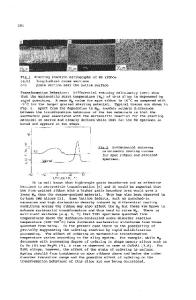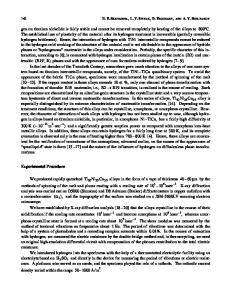Two-way shape memory effect of TiNi alloys induced by hydrogenation
- PDF / 252,269 Bytes
- 7 Pages / 612 x 792 pts (letter) Page_size
- 3 Downloads / 275 Views
INTRODUCTION
THE interaction between hydrogen atoms and Ti-Nibased alloys has received significant attention. Originally, the problem of hydrogen was encountered when the product of the interaction-hydrides in thin Ti-Ni shape memory alloy (SMA) specimens prepared for transmission electron microscopy (TEM) that had been subjected to electropolishing were erroneously interpreted by TEM as a new premartensitic phase with monoclinic structure.[1] Besides, the hydrogen absorbing behavior of Ti2Ni-based alloys also received attention for its potential for hydrogen storage.[2] Later, the influence of hydrogenation on the shape memory effect (SME) of SMAs was studied.[3] Hydrogenation of Ti-Ni-based SMAs is accompanied by a high diffusivity of hydrogen[4] in these alloys and results in the formation of hydrides.[5] In some studies, the hydrogenation of Ti-Ni was achieved electrochemically[1,4] or by putting specimens into a high hydrogen pressure environment.[2] After hydrogenation, the hydrides are found to be relatively unstable, prevailingly distributed in subsurface regions close to the free surface; consequently, hydrogen gradually diffuses out of the specimens. In the work of Nam and co-authors, the electrochemical hydrogenation was realized in a forced method.[5] This means the specimen is arranged as a cathode that results in the formation of hydrides with an extended life in comparison to that of electropolishing with the specimen as an anode. Hence, the forced way of hydrogenation was acquired in the present investigation. The influence of hydrogenation on SME in TiNi SMA was studied by Wade and co-authors,[3] and they concluded that hydrogenation caused a shift of transformation temperatures in TiNi SMA and degraded the SME. Shorshorov and CHING-CHICH LEU, former Graduate Student, Department of Materials Science and Engineering, National Tsing Hua University, is Assistant Researcher, National Nano Device Lab, Hsinchu, 300, Taiwan, Republic of China. DAVID VOKOUN, Postdoctor, and CHEN-TI HU, Professor, are with the Department of Materials Science and Engineering, National Tsing Hua University, Hsinch, 30043, Taiwan, Republic of China. Manuscript submitted April 2, 2001. METALLURGICAL AND MATERIALS TRANSACTIONS A
co-authors studied hydrogenation-induced martensitic transformation in Ti-Ni-based alloys with X-ray diffraction.[6] They did not recognize the formation of a new phase (hydride) but, instead, suggested that the presence of hydrogen resulted in weakening of the lattice binding forces of their material. At present, to our knowledge, the two-way shape memory effect (TWSME) in TiNi SMA has not been studied with respect to hydrogenation. The TWSME is one of the unique phenomena in TiNi SMA. During TWSME, an SMA specimen exhibits switching between “cold” and “hot” shapes by changing temperature in a certain temperature range and may cycle repeatedly between these two shapes. The strain of TWSME in near-equiatomic TiNi SMA could reach up to 6 pct and decrease with a number of thermal cycles.[7] Basically, TWS
Data Loading...











